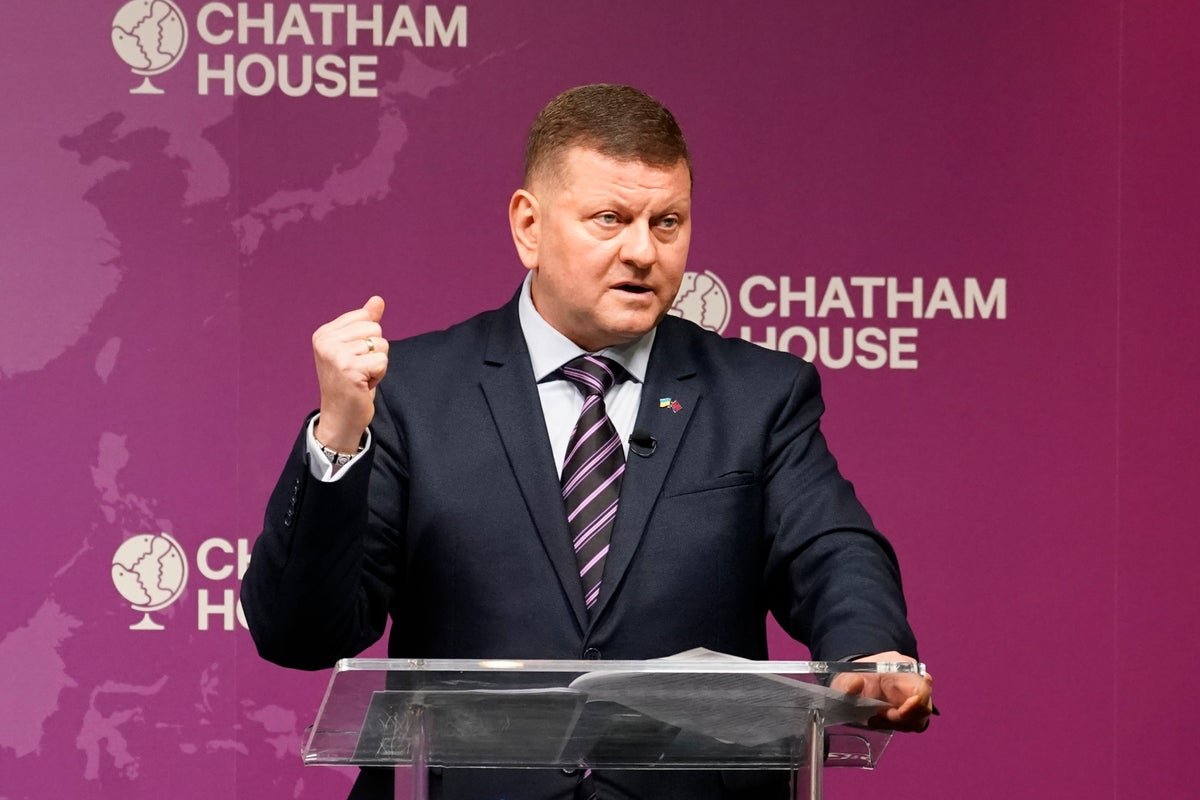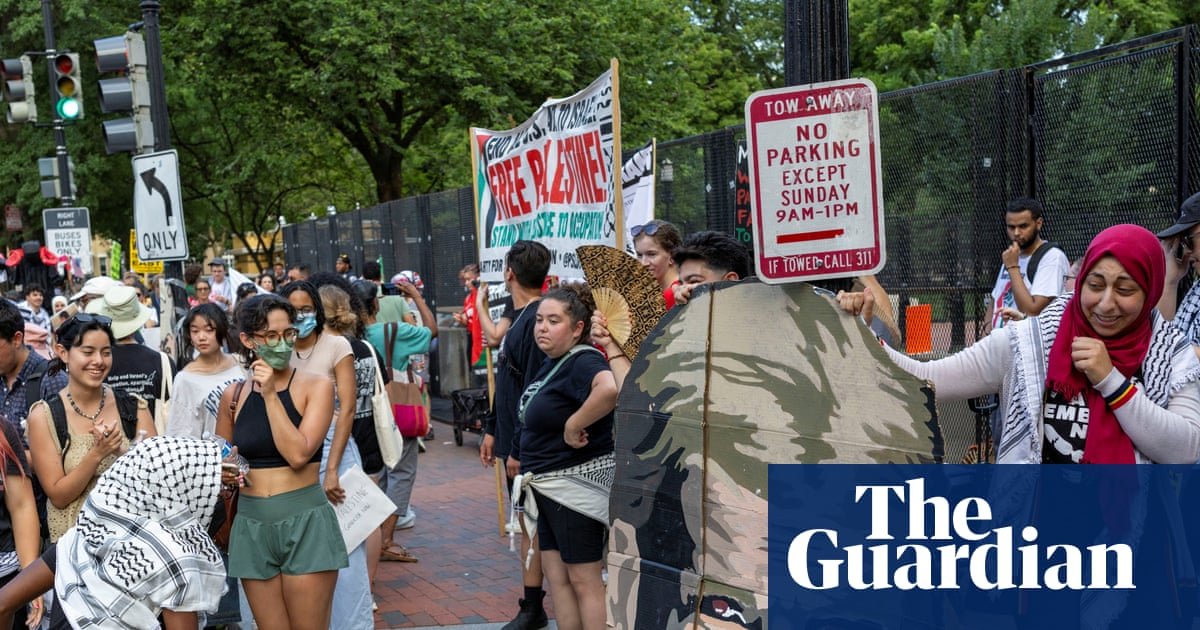Notifications can be managed in browser preferences.
Please refresh the page or navigate to another page on the site to be automatically logged inPlease refresh your browser to be logged in
Next article
Former top commander says frontline between Ukraine and Russia ‘exists mainly for killing’
I would like to be emailed about offers, events and updates from The Independent. Read our Privacy notice
Ukraine’s war against Russia could last until 2034, the former Ukrainian commander-in-chief and current ambassador to the UK has warned.
Valerii Zaluzhnyi, who led Ukraine’s war effort until last year, said: “If we try to establish a ceasefire without building up our future defences, the war will drag on for many more years. It began in 2014 – God willing, it will end in 2034.
Zaluzhnyi said the conflict had descended into a war of attrition, saying: “Right now, the front line exists mainly for killing. In 2022, tanks rode in front, and personnel followed them… Now, tanks and soldiers have switched places.”
His comments came as the Institute for the Study of War warned Russia’s recent military reforms “demonstrate Russia’s longer-term preparation for a possible future conflict with Nato“.
Ukraine and Russia exchanged fresh drone attacks on Thursday, shortly after the conclusion of the latest round of direct peace talks between Moscow and Kyiv. A nine-year-old was among seven people injured after Russia attacked the central region of Cherkasy, damaging more than a dozen residential apartment buildings.
At least 80,000 Russian soldiers were killed or injured in Ukraine’s audacious Kursk incursion, the war-hit country’s commander-in-chief Oleksandr Syrskyi said.
The Kursk occupation “ultimately killed or wounded at least 80,000 Russian troops,” Syrsky told the Washington Post on Wednesday. The Ukrainian military official declined to disclose Ukrainian casualties there but said they were significantly fewer than Russia’s.
Ukraine launched a counteroffensive in the Russian border region of Kursk in August last year, pushing several miles through its southeastern flank.
Russia’s recent military reforms show long-term preparations for a future conflict with Nato, a US-based think tank has said.
“ISW continues to assess that Russia’s military reforms, including the restructuring of the Western Military District (WMD) into the Leningrad and Moscow military districts (LMD and MMD), demonstrate Russia’s longer-term preparation for a possible future conflict with Nato,” the Institute for the Study of War said in its latest assessment.
It added: “Russia’s ability to more quickly conduct large-scale call-ups will have significant implications for Nato and its ability to deter or even defend against future Russian aggression.”
Russia’s aerial strikes on Ukraine have massively increased since June, with intense peaks. Figures show that the six most concentrated attacks have taken place in the past month.
Putin’s forces have launched 5,402 drones and missiles against Ukraine so far this month, with the pace of attacks surging sharply in recent weeks, according to figures from Ukraine’s air force.
The deadliest single day came on 9 July, when Moscow fired 741 drones and missiles. This was followed by other intense barrages, including 623 on 12 July and 550 on 4 July.
While the number of strikes dipped mid-month with just 35 reported on 18 July and 64 on 17 July, the pace has picked up again over the past week, with 330 weapons fired on Saturday and a further 450 on Sunday.
Russia’s air defence systems destroyed 105 Ukrainian drones overnight in nine regions and over the Sea of Azov, the Russian defence ministry said this morning.
Most of these were downed over bordering regions near Ukraine, including Belgorod, Bryansk and Kursk, the defence ministry said on Telegram.
Russian forces are making every effort to establish buffer zones along the border with Ukraine, state news agency RIA quoted Kremlin spokesperson Dmitry Peskov as saying.
He was speaking a day after a brief third round of peace talks between Russia and Ukraine where the two sides discussed further humanitarian exchanges but made no progress towards a ceasefire.
TASS news agency quoted Mr Peskov as saying that no breakthrough had been expected.
In May this year, Russian president Vladimir Putin announced his troops would aim to capture more Ukrainian territory along the border to help prevent Ukrainian incursions into Russia.
Ukrainian president Volodymyr Zelensky has defended his new anti-corruption bill which has sparked widespread protests in the country and said that the bill is well-balanced and fulfils promise of justice.
“Today, my bill is already in the Verkhovna Rada of Ukraine – fulfilling my promise – for justice, for law enforcement and anti-corruption agencies. Full-fledged guarantees of the independence of anti-corruption agencies. Real opportunities to verify, so that any Russian interference is kept out,” Mr Zelensky said in his nightly address.
“Everyone who has access to state secrets, and this includes not only the NABU and SAPO, but also the SBI, the National Police, must undergo lie detector tests. These must be regular checks,” he said.
He also acknowledged the protests and said: “And of course, it is important that Ukrainians are responding with such dignity to everything thatʼs happening. Ukraine is a country of people who donʼt look away.”
Inside Russia’s suicide drone factories, production of Shahed drones is being rapidly increased as Vladimir Putin steps up efforts to intensify attacks on Ukraine with expanded weapon supplies.
A Russian state TV report, which aired on Sunday offered a rare look inside a major factory in Tatarstan that produces Russian versions of Iran’s Shahed-136 drones.
The propaganda broadcast showed matte black Geran-2 drones, highlighting their role in the conflict.
Hours after the report, Russia launched at least 57 drone and missile strikes on Ukraine, killing at least one person — despite Kremlin claims that Putin remains open to peace talks.
Ukraine’s war against Russia could last until 2034, the country’s former commander-in-chief and current ambassador to the UK warned.
Valerii Zaluzhnyi, who led Ukraine’s war effort until last year said: “If we try to establish a ceasefire without building up our future defences, the war will drag on for many more years. It began in 2014 — God willing, it will end in 2034.”
Mr Zaluzhnyi, speaking to Ukrainian news outlet LB.ua, said Kyiv entered a new and radically different phase of the war with Russia in 2024.
“Right now, the front line exists mainly for killing,” Mr Zaluzhnyi said. “In 2022, tanks rode in front, and personnel followed them… Now, tanks and soldiers have switched places.”
He also noted a shift in Russian forces and their battlefield tactics. Mr Zaluzhnyi said the Kremlin had abandoned direct assaults and now focussed on a war of attrition to target Ukrainian civilians and military.
Thousands of people, including veterans, took to the streets of Kyiv on Tuesday evening to protest against Volodymyr Zelensky’s anti-corruption measures.
The demonstrations, which have reportedly spread to Lviv and Dnipro, are the first public protests against the Ukrainian president since the Russian invasion in February 2022.
Some of those outside Mr Zelensky’s presidential office claimed Ukraine was “turning into Russia”, with placards reading “Welcome to Russia”, according to reports.
So why are people protesting, and what are the anti-corruption measures? The Independent takes a closer look below.
British prime minister Keir Starmer and Ukrainian president Volodymyr Zelensky spoke yesterday and agreed on the importance of the independence of anti-corruption agencies in the war-torn country, Downing Street said.
Mr Zelensky vowed on Wednesday to retain the independence of the anti-corruption agencies, bowing to pressure from the first wartime street protests and rare rebukes from European allies.
“The Prime Minister underlined the UK’s unwavering support for Ukraine, and the leaders agreed on the importance of the role of independent anti-corruption institutions at the heart of Ukraine’s democracy,” a British readout of Sir Keir and Mr Zelensky’s call said.
Join thought-provoking conversations, follow other Independent readers and see their replies
Please refresh the page or navigate to another page on the site to be automatically logged inPlease refresh your browser to be logged in
Ukraine war latest news: Putin’s war can go on until 2034, Ukrainian general warns – The Independent



